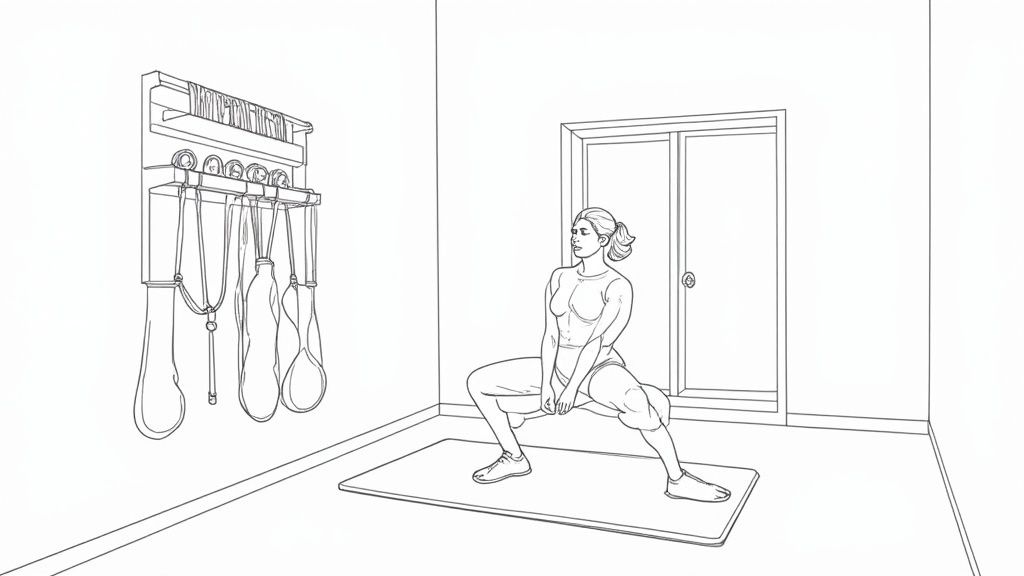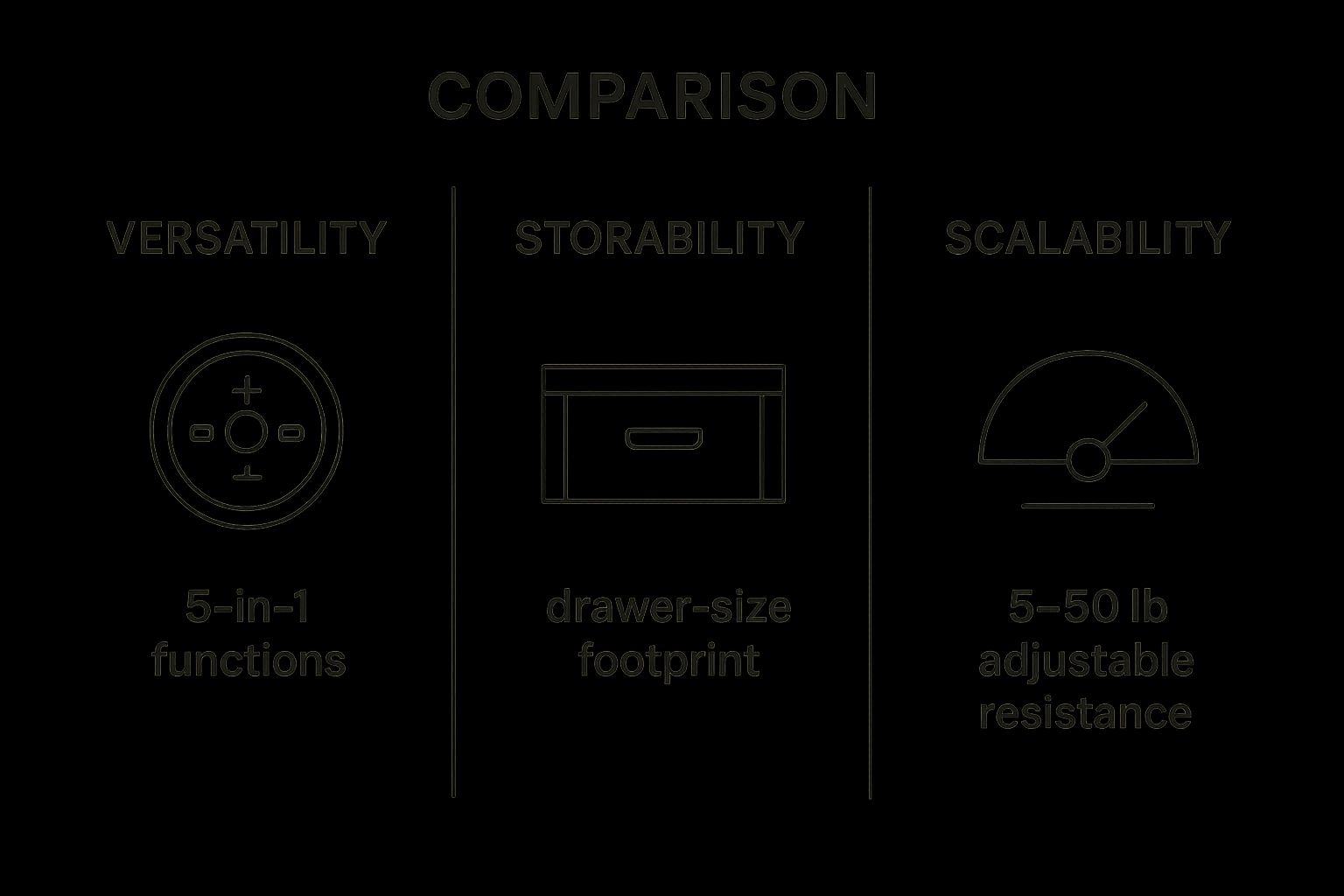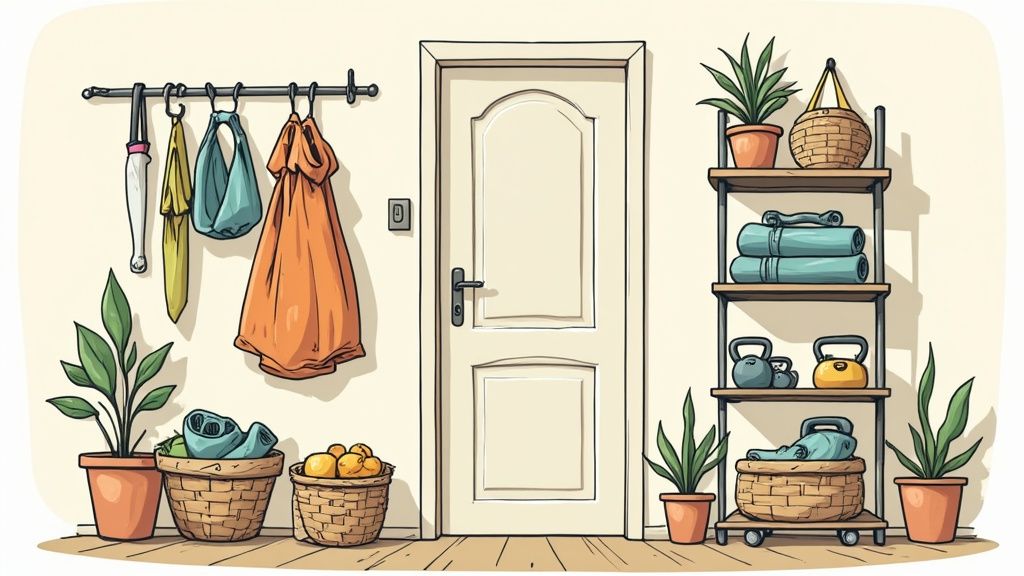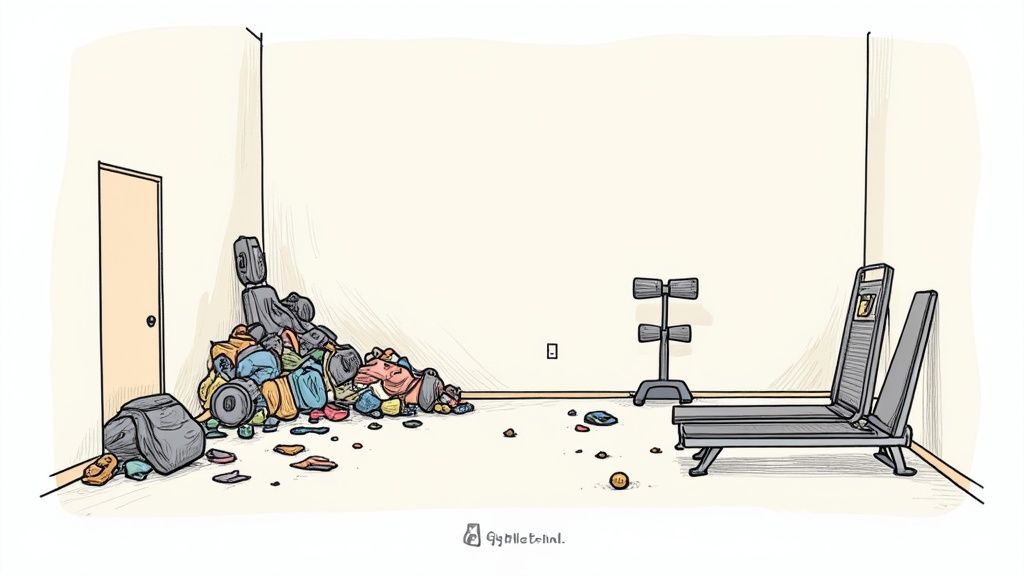Building a home gym when you're short on space isn't about compromise—it's about being smart. Here at Bare Fitness, we believe your cozy corner or small apartment is the perfect place to build a powerful fitness routine. The secret? Choosing versatile, multi-functional pieces that work as hard as you do and can be tucked away when you're done.
Forget the idea that you need a dedicated room. This guide will show you how to select clever, effective, and storable gear to get you moving. We'll cover everything from the "bare essentials" to smart strength-building tools, helping you create a workout zone you'll actually be excited to use.
Reclaiming Your Space for Fitness
It’s easy to fall into the trap of thinking, "My apartment is too small for a real workout." Let's flip that script. The real question is, "How can I make this space work for me?" Your living space—no matter the size—is your biggest fitness advantage.

This guide is all about getting powerful results with clever, multi-use, and storable gear. You absolutely do not need a dedicated room to build a fitness routine that's both consistent and effective.
The Rise of the Compact Home Gym
The desire for at-home fitness isn't just a fleeting trend; it’s a full-blown movement. You’re definitely not alone in looking for a better way to work out without leaving the house.
The proof is in the numbers. The global at-home fitness equipment market was valued at a hefty USD 9.34 billion in 2024. Even more telling, it’s expected to more than double, reaching USD 20.56 billion by 2034. That's a massive shift, showing just how many people are making fitness a seamless part of their home life. You can learn more about the latest trends in at-home fitness and see just how big this change is.
This boom has been great for us. It's pushed manufacturers to get creative, designing gear that's more compact and efficient than ever. Thanks to innovations in collapsible designs and smart tech, today's home gym equipment for small spaces is a world away from the clunky machines of the past.
Your home gym doesn't need to be perfect; it just needs to be practical. The goal is to create an inviting space that makes you want to move, even on the busiest days.
To help you get started, here's a quick look at the strategies we'll be covering. Think of it as your cheat sheet for building a functional and motivating workout corner.
Your Quick Guide to a Small Space Gym
These core ideas will be our guide as we dive into selecting the perfect equipment and setting up your space for success.
Core Principles for Your Small Gym
To build a workout area you’ll actually want to use, let's stick to a few foundational principles. Keep these in mind as you start picking out gear and mapping out your little fitness haven.
- Vertical Victory: Look up! Wall space is your best friend for storage. Getting mats, bands, and other accessories off the ground is a total game-changer.
- Collapsible Champions: Prioritize equipment that can fold, shrink, or be taken apart. This is how you get your living room back after a tough session.
- Bodyweight Boosters: Focus on simple tools that make bodyweight exercises even more effective. You’ll get a much bigger bang for your buck without cluttering your space.
By embracing these concepts, you can turn any corner into a fitness powerhouse. This guide will walk you through everything, from finding the right equipment to designing a routine you’ll love. Let’s get started.
A Smart Buyer's Guide to Compact Gym Gear
Hold on before you start clicking "add to cart." Let's map out a smarter strategy first. Picking the right home gym equipment for small spaces isn't about grabbing the latest shiny gadget; it’s about investing in tools that will actually work for you, both now and down the road. The best choices always come down to three core ideas: Versatility, Storability, and Scalability.
Think of these as the foundation for a home gym that’s effective and doesn't take over your living space. Nailing these three will help you buy gear you'll actually use for years, so you can avoid that all-too-common pile of dusty, space-hogging equipment.
Pillar 1: Versatility
In a small space, versatility is your superpower. It’s all about finding one piece of equipment that can do the job of five different machines. This approach doesn't just save precious floor space; it also makes your workouts more efficient, letting you flow from one exercise to the next without a hitch.
Before any piece of equipment gets your money, ask yourself this simple question: "How many different exercises can I really do with this?"
- Adjustable Dumbbells: Instead of a massive rack of weights that needs its own wall, a single pair of adjustable dumbbells can give you a weight range from 5 to 50 pounds (or more!). They’re fantastic for everything from bicep curls and overhead presses to weighted lunges and goblet squats.
- Resistance Bands with Handles: These might just be the most adaptable tool you can own. Anchor them to a door for chest presses and rows, stand on them for shoulder work, or loop them over a bar for pull-up assistance. The possibilities are nearly endless.
The goal here is to build a fitness toolkit, not a museum of single-use items. Every piece you bring into your home should be a hardworking, multi-functional part of your routine.
Pillar 2: Storability
Storability is all about what happens when the workout is over. The best gear for a compact home is the kind that practically vanishes when you're done. This is non-negotiable if your gym shares space with your living room, bedroom, or home office.
You want to look for equipment that is either tiny to begin with or brilliantly designed to fold, collapse, or tuck away out of sight.
- Collapsible Equipment: Think of things like a foldable weight bench or a rower that can be stored upright in a closet or slid flat under a bed.
- Drawer-Sized Gear: High-quality resistance bands, a good jump rope, and suspension trainers can all fit neatly into a single drawer or a small decorative basket.
Focusing on storability means your fitness routine can be a seamless part of your life, not a constant, cluttered obstacle. It keeps your space feeling open and livable, which is key to staying motivated.
Pillar 3: Scalability
Finally, scalability is what makes sure your equipment can keep up with you. As you get stronger and more confident, your gear needs to be able to serve up a tougher challenge. This is why buying equipment with adjustable resistance is one of the smartest moves you can make.
This simple foresight prevents that frustrating moment when you "outgrow" your gear and have to buy something new just a few months in.
Look for equipment that offers:
- Adjustable Resistance: This is the most straightforward way to scale. Adjustable dumbbells and kettlebells let you simply dial up the weight as you get stronger.
- Progressive Band Levels: Most resistance band sets come with multiple bands of varying tensions. You can use them one at a time or combine them for a seriously tough workout.
- Skill-Based Progression: Some equipment, like a simple doorframe pull-up bar, challenges you indefinitely. You can progress from just hanging to doing negative reps, then full pull-ups, and eventually even more advanced variations.
This kind of forward-thinking makes your initial investment go so much further and supports a fitness habit you can stick with for the long haul. It's no surprise that this is where the industry is heading. With the home fitness market estimated at USD 12.4 billion in 2025 and projected to hit USD 19.6 billion by 2035, manufacturers are increasingly focused on these kinds of compact, scalable solutions. You can discover more insights into the growing home gym equipment market to see the trends for yourself. By choosing your gear wisely now, you're setting yourself up for years of success.
Building Your Essential Equipment List
Alright, let's get to the fun part—picking out your gear. When you're working with a small space, choosing the right home gym equipment isn't about how much you can buy; it's about how smart you can buy. We're going to break down the best options into a few simple tiers. This way, you can build a personalized toolkit that actually fits your goals, your budget, and your floor plan.
This isn't just a shopping list. It's about making sure every single piece you bring into your home is a hardworking, versatile player in your fitness journey. Let's build your perfect compact gym, one smart choice at a time.
The Bare Essentials Foundation
Every great home gym, no matter how tiny, starts with a solid foundation. These are the non-negotiable basics that you'll use for almost any kind of workout. Think of them as the canvas for your fitness routine—they're simple, they're affordable, and they're surprisingly effective.
- A Quality Workout Mat: This is so much more than just a piece of foam. A good mat defines your workout zone, saves your floors (and your downstairs neighbors), and protects your joints during floor exercises. It also gives you a clean, comfortable spot for push-ups, core work, and stretching. Make sure you get one that rolls up tight for easy storage.
- Resistance Bands (Loop and Handled): If there’s one piece of equipment that truly embodies the small-space fitness philosophy, it's resistance bands. They are the absolute champion of space-saving strength training and can be tucked away in any drawer. A good set with different resistance levels lets you hit every single muscle group for toning, strength, and even physical therapy-style exercises.
Your fitness journey starts with a single step. These foundational tools prove you don't need a lot of complicated gear to get a fantastic workout—just the right gear.
The Strength Builders: Game Changers
Once you've got the basics covered, it’s time to add a couple of key items that will seriously upgrade your strength training. These pieces are all about delivering maximum challenge with a minimal footprint, letting you build real muscle without cluttering up your living room.
This infographic really drives home what to look for in smart, compact equipment—it's all about versatility, storability, and scalability.

As you can see, a single adjustable tool can easily replace a whole rack of weights, store away in a tiny footprint, and grow with you as you get stronger.
Here are the best options for building strength:
- Adjustable Dumbbells or Kettlebells: This is where you get the most bang for your buck, hands down. A single pair of adjustable dumbbells can take the place of an entire weight rack, giving you a range from 5 to 50 pounds (or even more). They’re perfect for everything from bicep curls to weighted lunges and will scale up as your strength improves.
- Doorframe Pull-Up Bar: Thinking vertically is the secret to small-space living, and a doorframe pull-up bar is the perfect example. It takes up zero floor space and is one of the best tools on the planet for building upper body and core strength. Many models are also removable and can be used on the floor for deeper push-ups or dips, adding to their value.
To help you weigh your options, here's a quick comparison of the most popular compact strength and cardio tools.
Comparing Top Compact Home Gym Equipment
Choosing the right piece of equipment can feel overwhelming, but breaking it down by function, space, and cost makes it much easier. This table compares the top contenders to help you find the perfect fit for your specific needs.
Ultimately, the best choice is the one you'll use consistently. A set of resistance bands you use every day is far more valuable than a foldable rower that just collects dust.
The Cardio Solvers: Smart Solutions
Cardio is essential, but let’s be real—most of us don't have room for a bulky treadmill or elliptical. Luckily, there are some brilliant, space-efficient alternatives that will get your heart pumping without taking over your apartment.
The demand for at-home fitness gear is exploding, largely because more people are living in smaller spaces. In fact, the home fitness equipment market was projected to hit around USD 31 billion by the end of 2025. This huge interest has pushed manufacturers to get creative and design better, more compact equipment. If you're curious about the trends, you can read the full market analysis on home fitness equipment growth and see what's driving all this innovation.
Here are our favorite cardio picks that respect your square footage:
- A Jump Rope: The humble jump rope is still one of the most efficient, affordable, and compact cardio tools you can own. It delivers a killer full-body workout, improves coordination, and disappears into a drawer when you're done. Just a few minutes of jumping rope can feel as intense as a much longer run.
- Foldable Stationary Bike or Rower: If you're ready to invest in a machine, make it a foldable one. Modern folding bikes and rowers are surprisingly solid and provide a fantastic, low-impact cardio workout. When you're finished, they fold up and roll away into a closet or corner, giving you your living room back instantly.
- Compact Under-Desk Elliptical: For the ultimate multitasker, an under-desk elliptical lets you get your blood flowing while you work or watch TV. It's a quiet, low-impact way to stay active during the day and easily slides under your desk or bed when not in use.
By thoughtfully picking a few items from each of these tiers, you can build a powerful and well-rounded home gym that fits neatly into your life. Start with the essentials, and then add new pieces as your fitness and your needs evolve.
Designing a Workout Zone You'll Actually Want to Use
Having the right gear is a great start, but the real secret to sticking with your routine is creating a space that actually makes you want to work out. Your fitness corner doesn’t need to be a professional studio. It just needs to feel functional, organized, and motivating. This is where we stop just owning home gym equipment for small spaces and start designing a zone that pulls you in.
The goal is pretty straightforward: turn that cluttered corner into an inspiring little fitness nook. A well-designed space removes the mental hurdles between thinking about a workout and actually doing one.

Vertical Victory: Going Up, Not Out
In any small apartment or home, floor space is gold. The most powerful trick for keeping your workout zone tidy is to think vertically. Getting your equipment off the floor doesn't just give you more room for your workout; it instantly makes the entire space feel bigger and less chaotic.
- Wall Mounts and Hooks: A few simple, sturdy hooks are perfect for hanging resistance bands, jump ropes, and even your workout mat. They’ll stay untangled, easy to grab, and completely out of the way.
- Modular Shelving: A narrow, vertical shelving unit can become a compact "fitness tower" for smaller items like a foam roller, yoga blocks, or a single adjustable kettlebell, all while taking up minimal floor space.
Undercover Fitness: Hiding in Plain Sight
Your workout equipment doesn't have to be on permanent display, especially if your gym is also your living room or bedroom. The "undercover" approach is all about using existing furniture and clever storage to keep your gear out of sight but still super easy to access. This is the key to maintaining a peaceful, uncluttered home.
Low-profile storage bins that slide under a bed or couch are a game-changer for stashing adjustable dumbbells, sliders, and other compact gear. When it’s time to work out, you just slide them out. When you're done, they completely disappear.
Your environment has a huge impact on your habits. An organized, accessible workout space is a visual cue that says, "It's time to move," making it so much easier to stay consistent.
Smart Storage for a Tidy Mind
Clutter is a motivation killer. If you have to spend the first five minutes of your workout untangling resistance bands, your enthusiasm is going to tank. Smart, thoughtful storage makes your fitness routine as seamless as possible.
Here are a few quick tips to get your space in order:
- Decorative Baskets or Bins: Who said storage has to be ugly? A nice woven basket or a stylish fabric bin can hold your foam roller, yoga blocks, and bands while blending right into your home decor.
- Over-the-Door Hangers: Don't forget about the back of your door! An over-the-door hanger with a few hooks is an amazing spot for resistance bands, a towel, or even a small gym bag.
- A Designated "Ready" Caddy: Keep your absolute must-haves—like a water bottle, workout tracker, and headphones—in a small caddy or tray. This little "go-station" ensures you have everything you need to start your workout without a frustrating search.
By mixing these vertical and undercover strategies, you can create a workout zone that feels both functional and calming. An organized space leads to a focused mind, and that helps you get the most out of every single session.
Putting Your Compact Gym to Work: Sample Routines
You’ve carved out your workout corner and have your gear ready. Now for the fun part! Having the right equipment is only half the battle—knowing how to put it all together for an effective workout is where you’ll see real results.
Let’s put that gear to work. Here are three distinct routines you can start today using the equipment we've been talking about. Think of these as templates to show you just how much you can achieve, even when you're short on space.
Workout 1: The 20-Minute Full-Body Strength Circuit
This circuit is designed to hit every major muscle group, fire up your metabolism, and build functional strength in just 20 minutes. The key is to move quickly from one exercise to the next, keeping rest to a minimum to keep your heart rate up.
What You'll Need:
- A set of adjustable dumbbells
- A resistance band (looped or with handles)
- Your workout mat
Step-by-Step Instructions:
Perform each exercise for the reps listed, then immediately move to the next. After completing all five moves, take a 60-second rest. Your goal is to complete 3-4 full rounds.
- Dumbbell Goblet Squats (12 reps): Hold one dumbbell vertically against your chest. Stand with your feet shoulder-width apart. Drop your hips back and down as if sitting in a chair, keeping your chest up. Drive back up through your heels.
- Push-Ups (10 reps): Start in a solid plank position. Lower your body until your chest is just above the floor, then press back up. Keep your core engaged the entire time.
- Dumbbell Renegade Rows (8 reps per side): In a high plank with a dumbbell in each hand, keep your hips still as you pull one dumbbell up to your chest, squeezing your back. Lower it with control and repeat on the other side.
- Banded Glute Bridges (15 reps): Lie on your back with knees bent and a loop band just above them. Drive your hips toward the ceiling, squeezing your glutes at the top.
- Dumbbell Overhead Press (10 reps): Sit or stand tall, holding a dumbbell in each hand at your shoulders. Press them straight overhead until your arms are fully extended, then lower them back down slowly.
Common Mistake to Avoid: For Renegade Rows, avoid rocking your hips. Widen your feet for a more stable base if you need to.
Progression: As you get stronger, increase the weight of your dumbbells or add an extra round to the circuit.
Workout 2: The 15-Minute HIIT Cardio Blast
No time is no excuse. This High-Intensity Interval Training (HIIT) session is your secret weapon for torching calories and boosting your cardio fitness when you're on a tight schedule. A simple jump rope is all it takes.
What You'll Need:
- A jump rope
- A timer (your phone is perfect)
Step-by-Step Instructions:
Set a timer for 15 minutes. You’ll work hard for 45 seconds, then rest for 15 seconds before moving to the next exercise. Keep cycling through the circuit until your time is up.
- Jump Rope: Stay light on the balls of your feet and find a steady rhythm.
- Bodyweight Squats: Focus on perfect form: chest up, back straight.
- Mountain Climbers: From a plank position, drive your knees toward your chest in a quick, alternating pattern.
- Jumping Jacks: The old-school classic for a reason! Keep it snappy.
Common Mistake to Avoid: Don't sacrifice form for speed. A slightly slower, correct movement is always better than a fast, sloppy one.
Modification: If jumping is too high-impact, you can step out your jumping jacks and perform high-knees instead of mountain climbers.
Workout 3: The 30-Minute Core and Flexibility Flow
Strength and cardio are fantastic, but a strong core and good mobility are what keep you injury-free and moving well. This routine is the perfect way to build that foundation, release tension, and help your body recover.
What You'll Need:
- Your workout mat
Step-by-Step Instructions:
Move through these exercises with intention and control. Don't rush. Focus on your breathing, holding each stretch for a full 30 seconds.
- Cat-Cow Stretch (10 reps): On all fours, inhale as you drop your belly and look up (Cow), then exhale as you round your spine to the ceiling (Cat).
- Bird-Dog (10 reps per side): From the same all-fours position, extend your right arm straight out and your left leg straight back. The trick is to keep your hips and shoulders perfectly level. Alternate sides.
- Plank (Hold for 30-60 seconds): On your forearms or hands, create a straight line from your head to your heels. Squeeze your glutes, quads, and core.
- Lying Knee-to-Chest Stretch (30 seconds per side): Lie on your back and gently hug one knee into your chest, feeling the stretch in your lower back and glute.
- Full Body Stretch: Finish by lying flat on your back. Reach your arms overhead and point your toes, creating as much length as possible from your fingertips to your toes.
Next Steps:
Consider these workouts your launchpad. As you get stronger, you can add more weight, shorten your rest periods, or swap in different exercises from our workout library. The best part about having your own space is that you get to call the shots.
Common Mistakes When Building a Home Gym
Getting started with a home gym is an exciting step, but it’s all too easy to stumble into a few common traps. Those missteps can quickly turn your dream workout space into a cluttered, frustrating corner you end up avoiding. Let's make sure that doesn't happen.

With a bit of foresight, you can build a gym that actually inspires you to move. We'll walk through the most frequent blunders and give you simple, practical ways to sidestep them.
Buying Before You Measure
This is, without a doubt, the number one mistake people make. You see a great deal on a compact treadmill, you get excited, and you hit "buy"—only for it to arrive and you realize it dominates the entire room. Even the most cleverly designed home gym equipment for small spaces needs clearance to be used safely.
Before you add anything to your cart, grab a tape measure. Map out not just the equipment's footprint, but also the "active zone" around it. You need to account for your full range of motion, whether that's the arc of a kettlebell swing or the space to fully extend during a push-up.
A few minutes with a tape measure now will save you the massive headache of trying to return a bulky piece of equipment later. It’s the simplest way to guarantee everything will fit perfectly.
Ignoring True Versatility
It's tempting to get drawn in by a specialized gadget that promises to perfect one specific movement. But when you're short on space, single-purpose items are your worst enemy. The goal is to find multi-functional workhorses that can grow and adapt with you.
Don't think about buying a separate machine for every muscle. Instead, think about the fundamental movement patterns you need to train.
- Ask yourself: "Can this single item help me push, pull, squat, and hinge?"
- Prioritize gear like: A good set of adjustable dumbbells, which can replace an entire rack of weights, or quality resistance bands that can challenge your whole body from different angles.
This mindset doesn't just save a ton of space; it saves you money and lets you build a truly comprehensive routine with a handful of key pieces.
Forgetting About the Floor
Your floor is the unsung hero of your home gym. It's easy to overlook, but neglecting it can lead to scratched hardwoods, unhappy downstairs neighbors, and even joint pain. A high-quality workout mat isn't optional; it's essential.
A good mat performs three critical jobs:
- Protects Your Surfaces: It's the first line of defense against scuffs and dings from dropped weights or intense cardio.
- Absorbs Sound: It significantly dampens the noise from jumping or setting down equipment, which is a game-changer in apartments.
- Cushions Your Joints: It provides vital support for floor work, yoga, and stretching, making your workouts safer and way more comfortable.
Investing in a thick, durable mat is one of the smartest and simplest moves you can make. It visually defines your workout zone and proves you're serious about building a functional and safe space. By sidestepping these common errors, you're setting yourself up for success with a gym that truly works for you.
Got Questions About Your Small Space Gym? We've Got Answers.
Okay, let's tackle those nagging questions. When you're starting out, a few uncertainties can be all that stands between you and a workout routine you'll actually stick with. So, let's clear the air on some of the most common things people ask when setting up a gym in a tight spot.
Our goal here is to help you push past those final hurdles with confidence. Let's get you set up in a space you'll be excited to use.
What's the Single Most Versatile Piece of Gear for an Apartment?
Hands down, a good set of adjustable dumbbells. No contest. Think about it: they replace an entire wall-length rack of weights, letting you do everything from heavy chest presses and goblet squats to lighter bicep curls and shoulder raises.
Once your workout's done, they tuck away into a corner. Combine them with a set of resistance bands, and you've basically covered all your strength training bases. For getting the most bang for your buck in a small space, nothing else comes close.
How Do I Get My Cardio in Without My Downstairs Neighbor Hating Me?
This is probably the biggest worry for anyone living in an apartment, but it's totally solvable. You just need to shift your focus to low-impact cardio that’s quiet but still gets your heart pumping. A foldable rowing machine is a fantastic choice; it gives you a killer full-body workout with barely a whisper of sound.
A few other neighbor-friendly options include:
- Stationary Bikes: These are notoriously quiet and take up very little floor space.
- Bodyweight Circuits: Just grab a thick exercise mat. It'll absorb the impact and sound from moves like squats, lunges, and planks.
- Resistance Bands: You can string together high-intensity circuits that are tough as nails but completely silent.
Can I Really Build a Decent Home Gym for Under $200?
You absolutely can. An effective workout space isn't about how much you spend; it's about making smart, strategic choices.
A great home gym is built with versatile tools that give you maximum results for your money, not with expensive, single-use machines.
If you're on a budget, start with these core items:
- Resistance bands with handles: Perfect for covering all your upper and lower body strength needs.
- A quality exercise mat: Don't skip this. It's crucial for protecting your joints (and your floors).
- A jump rope: It’s one of the most efficient, cheapest cardio tools on the planet.
- One heavy kettlebell: A single bell opens up a world of dynamic, full-body movements.
With just these four things, you can perform hundreds of different exercises. You'll have everything you need for strength, cardio, and flexibility, all while keeping your spending well under $200.
How Do I Actually Stay Motivated to Use My Home Gym?
Ah, motivation—the secret sauce. The first step is to create a space that feels inviting, even if it’s just a clean, well-organized corner. When your gear is out and ready to go, there’s one less barrier to getting started.
Next, take the thinking out of it. Follow a structured program or use a fitness app so you never have to ask, "What should I do today?" But here’s the most important part: find something you genuinely like doing. Consistency comes from enjoyment, not just sheer willpower. When you actually look forward to your workout, staying motivated becomes a whole lot easier.
Ready to build a fitness routine that fits your life, not the other way around? At Bare Fitness, we provide the guidance and support you need to achieve your goals with minimal equipment and maximum results. Explore our resources and start your journey today at https://barefitness.com.



















